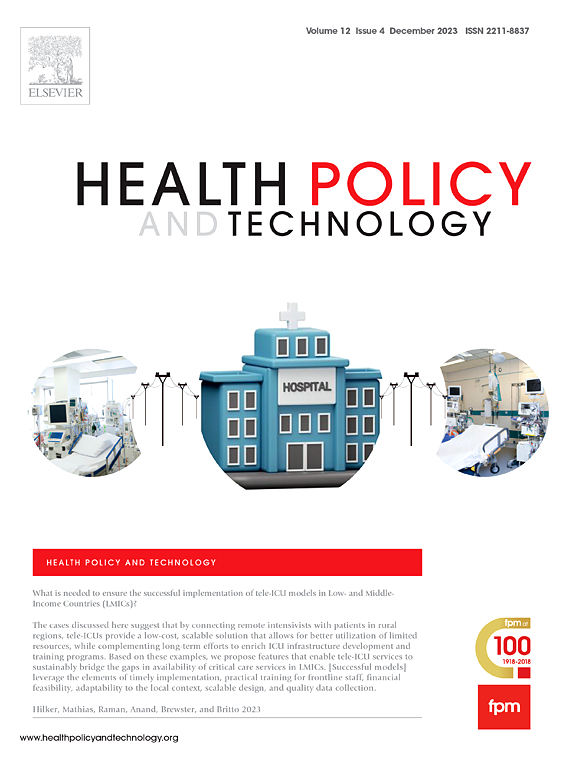Willingness to pay for remote and self-monitoring: Comparing patients and non-patients in gestational hypertensive care
IF 3.7
3区 医学
Q1 HEALTH POLICY & SERVICES
引用次数: 0
Abstract
Objectives
Contingent valuation (CV) is widely used in health economics, as it enables the quantification of diverse benefits within a single monetary measure. However, a key methodological debate that remains underexplored is whether patients or non-patients should complete the CV task and how this choice may influence willingness to pay (WTP) estimates. This study aimed to investigate that question in the context of two home blood pressure (BP) monitoring approaches for pregnant women at risk of gestational hypertensive disorders, remote monitoring (RM) and patient self-monitoring (PSM). We also examined the role of patient status and treatment experience in shaping WTP.
Methods
The WTP of 199 patients and 222 non-patients was examined using a CV survey, combining a payment card and open-ended question. Propensity score matching analysis with regression adjustment assessed WTP differences between patients and non-patients. Subgroup analyses explored whether these differences were driven solely by being a patient or also by home BP monitoring experience.
Results
The mean WTP was €130 for RM and €85 for PSM. Patients exhibited a €31 higher WTP for RM compared to non-patients, a difference that was marginally significant at the 10 % level. This effect was driven by treatment experience status. We found no significant difference in WTP PSM between patients and non-patients.
Conclusions
Simply being a patient does not affect WTP for home BP monitoring. When patients have treatment experience, this can increase WTP compared to non-patients, but not for approaches for which the potential benefits are apparent without experiencing them, like PSM.
支付远程和自我监测的意愿:比较患者和非患者在妊娠期高血压护理
条件评估(CV)在卫生经济学中被广泛使用,因为它可以在单一货币措施中量化各种效益。然而,一个关键的方法论争论仍未得到充分探讨,即患者或非患者是否应该完成CV任务,以及这种选择如何影响支付意愿(WTP)估计。本研究旨在通过对妊娠期高血压疾病风险孕妇的两种家庭血压监测方法——远程监测(RM)和患者自我监测(PSM)来探讨这一问题。我们还研究了患者状态和治疗经验在形成WTP中的作用。方法采用支付卡和开放式问题相结合的CV调查方法,对199例患者和222例非患者的WTP进行检测。倾向评分匹配分析与回归调整评估患者和非患者的WTP差异。亚组分析探讨了这些差异是否仅仅是由患者驱动的,还是由家庭血压监测经验驱动的。结果RM的平均WTP为130欧元,PSM的平均WTP为85欧元。与非患者相比,RM患者的WTP高出31欧元,差异在10%的水平下显着。该效应受治疗经验状态的驱动。我们发现患者与非患者的WTP PSM无显著差异。结论单纯的患者身份不影响家庭血压监测的WTP。当患者有治疗经验时,与非患者相比,这可以增加WTP,但对于那些没有经历就能明显获益的方法,如PSM,则不是这样。
本文章由计算机程序翻译,如有差异,请以英文原文为准。
求助全文
约1分钟内获得全文
求助全文
来源期刊

Health Policy and Technology
Medicine-Health Policy
CiteScore
9.20
自引率
3.30%
发文量
78
审稿时长
88 days
期刊介绍:
Health Policy and Technology (HPT), is the official journal of the Fellowship of Postgraduate Medicine (FPM), a cross-disciplinary journal, which focuses on past, present and future health policy and the role of technology in clinical and non-clinical national and international health environments.
HPT provides a further excellent way for the FPM to continue to make important national and international contributions to development of policy and practice within medicine and related disciplines. The aim of HPT is to publish relevant, timely and accessible articles and commentaries to support policy-makers, health professionals, health technology providers, patient groups and academia interested in health policy and technology.
Topics covered by HPT will include:
- Health technology, including drug discovery, diagnostics, medicines, devices, therapeutic delivery and eHealth systems
- Cross-national comparisons on health policy using evidence-based approaches
- National studies on health policy to determine the outcomes of technology-driven initiatives
- Cross-border eHealth including health tourism
- The digital divide in mobility, access and affordability of healthcare
- Health technology assessment (HTA) methods and tools for evaluating the effectiveness of clinical and non-clinical health technologies
- Health and eHealth indicators and benchmarks (measure/metrics) for understanding the adoption and diffusion of health technologies
- Health and eHealth models and frameworks to support policy-makers and other stakeholders in decision-making
- Stakeholder engagement with health technologies (clinical and patient/citizen buy-in)
- Regulation and health economics
 求助内容:
求助内容: 应助结果提醒方式:
应助结果提醒方式:


